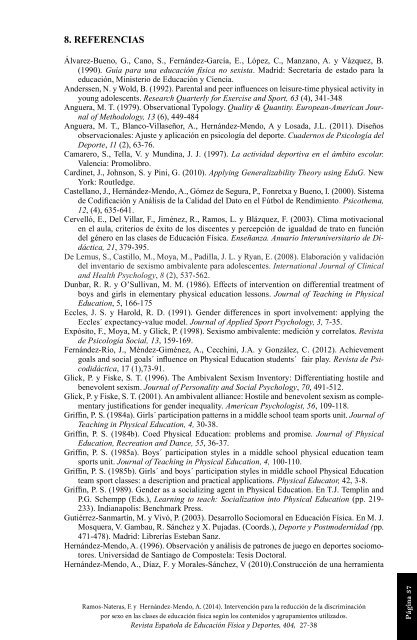REEFD404
REEFD404
REEFD404
Create successful ePaper yourself
Turn your PDF publications into a flip-book with our unique Google optimized e-Paper software.
8. REFERENCIAS<br />
Álvarez-Bueno, G., Cano, S., Fernández-García, E., López, C., Manzano, A. y Vázquez, B.<br />
(1990). Guía para una educación física no sexista. Madrid: Secretaría de estado para la<br />
educación, Ministerio de Educación y Ciencia.<br />
Anderssen, N. y Wold, B. (1992). Parental and peer influences on leisure-time physical activity in<br />
young adolescents. Research Quarterly for Exercise and Sport, 63 (4), 341-348<br />
Anguera, M. T. (1979). Observational Typology. Quality & Quantity. European-American Journal<br />
of Methodology, 13 (6), 449-484<br />
Anguera, M. T., Blanco-Villaseñor, A., Hernández-Mendo, A y Losada, J.L. (2011). Diseños<br />
observacionales: Ajuste y aplicación en psicología del deporte. Cuadernos de Psicología del<br />
Deporte, 11 (2), 63-76.<br />
Camarero, S., Tella, V. y Mundina, J. J. (1997). La actividad deportiva en el ámbito escolar.<br />
Valencia: Promolibro.<br />
Cardinet, J., Johnson, S. y Pini, G. (2010). Applying Generalizability Theory using EduG. New<br />
York: Routledge.<br />
Castellano, J., Hernández-Mendo, A., Gómez de Segura, P., Fonretxa y Bueno, I. (2000). Sistema<br />
de Codificación y Análisis de la Calidad del Dato en el Fútbol de Rendimiento. Psicothema,<br />
12, (4), 635-641.<br />
Cervelló, E., Del Villar, F., Jiménez, R., Ramos, L. y Blázquez, F. (2003). Clima motivacional<br />
en el aula, criterios de éxito de los discentes y percepción de igualdad de trato en función<br />
del género en las clases de Educación Física. Enseñanza. Anuario Interuniversitario de Didáctica,<br />
21, 379-395.<br />
De Lemus, S., Castillo, M., Moya, M., Padilla, J. L. y Ryan, E. (2008). Elaboración y validación<br />
del inventario de sexismo ambivalente para adolescentes. International Journal of Clinical<br />
and Health Psychology, 8 (2), 537-562.<br />
Dunbar, R. R. y O’Sullivan, M. M. (1986). Effects of intervention on differential treatment of<br />
boys and girls in elementary physical education lessons. Journal of Teaching in Physical<br />
Education, 5, 166-175<br />
Eccles, J. S. y Harold, R. D. (1991). Gender differences in sport involvement: applying the<br />
Eccles´ expectancy-value model. Journal of Applied Sport Psychology, 3, 7-35.<br />
Expósito, F., Moya, M. y Glick, P. (1998). Sexismo ambivalente: medición y correlatos. Revista<br />
de Psicología Social, 13, 159-169.<br />
Fernández-Río, J., Méndez-Giménez, A., Cecchini, J.A. y González, C. (2012). Achievement<br />
goals and social goals´ influence on Physical Education students´ fair play. Revista de Psicodidáctica,<br />
17 (1),73-91.<br />
Glick, P. y Fiske, S. T. (1996). The Ambivalent Sexism Inventory: Differentiating hostile and<br />
benevolent sexism. Journal of Personality and Social Psychology, 70, 491-512.<br />
Glick, P. y Fiske, S. T. (2001). An ambivalent alliance: Hostile and benevolent sexism as complementary<br />
justifications for gender inequality. American Psychologist, 56, 109-118.<br />
Griffin, P. S. (1984a). Girls´ participation patterns in a middle school team sports unit. Journal of<br />
Teaching in Physical Education, 4, 30-38.<br />
Griffin, P. S. (1984b). Coed Physical Education: problems and promise. Journal of Physical<br />
Education, Recreation and Dance, 55, 36-37.<br />
Griffin, P. S. (1985a). Boys´ participation styles in a middle school physical education team<br />
sports unit. Journal of Teaching in Physical Education, 4, 100-110.<br />
Griffin, P. S. (1985b). Girls´ and boys´ participation styles in middle school Physical Education<br />
team sport classes: a description and practical applications. Physical Educator, 42, 3-8.<br />
Griffin, P. S. (1989). Gender as a socializing agent in Physical Education. En T.J. Templin and<br />
P.G. Schempp (Eds.), Learning to teach: Socialization into Physical Education (pp. 219-<br />
233). Indianapolis: Benchmark Press.He Hernáz<br />
Gutiérrez-Sanmartín, M. y Vivó, P. (2003). Desarrollo Sociomoral en Educación Física. En M. J.<br />
Mosquera, V. Gambau, R. Sánchez y X. Pujadas. (Coords.), Deporte y Postmodernidad (pp.<br />
471-478). Madrid: Librerías Esteban Sanz.<br />
Hernández-Mendo, A. (1996). Observación y análisis de patrones de juego en deportes sociomotores.<br />
Universidad de Santiago de Compostela: Tesis Doctoral.<br />
Hernández-Mendo, A., Díaz, F. y Morales-Sánchez, V (2010).Construcción de una herramienta<br />
Ramos-Nateras, F. y Hernández-Mendo, A. (2014). Intervención para la reducción de la discriminación<br />
por sexo en las clases de educación física según los contenidos y agrupamientos utilizados.<br />
Revista Española de Educación Física y Deportes, 404, 27-38<br />
Página 37


